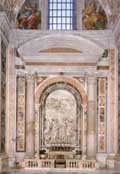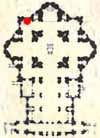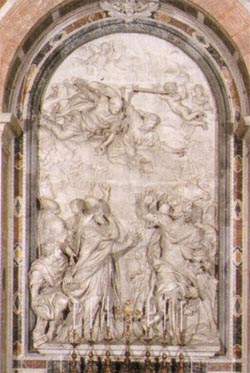| Grottoes
Vatican City Colonnade Saints Floorplan #2 |
| Altars
Monuments The History |
| Related
Items Our Lady Chapel |

|
From:
'St. Peter's - Guide to the Basilica and Square '
On the right of the chapel is the Altar of St. Leo the Great (440-461),
the first pope to be buried in the basilica. When he died, he was buried
in the sacristy of the ancient basilica, and his body was subsequently
moved to the Porticus Pontificum. Finally, Paul V desired it to be translated
to this chapel, together with the remains of Popes Leo II, Leo III, Leo
IV and Gregory XIII. The great carved marble altarpiece by Alessandro
Algardi (1602-1625) portrays the Meeting of Pope Leo the Great with Attila,
King of the Huns, whose advance on Rome in 452 the Pope had succeeded
in halting, thereby saving Rome from destruction.
From:
'Guide to Saint Peter's Basilica'
St. Peter's Basilica is honored by containing the tomb and mortal remains
of its famous son, the pope St. Leo the Great (440-461), incomparable
defender of Church doctrine against heresies. His writings, the Homilies,
in classical style are still as current as ever. He was called the "Savior
of the West", even though he could not prevent the sack of Rome by the
Vandals in 455.
Above the altar where he is buried, there is a majestic, high-relief marble portrait of Leo the Great as he met Attila the Hun, the scourge of god, near Mantua. The Pope's words were convincing, Attila was persuaded not to attack Rome. He told his troops that when the Pope spoke he saw the threatening figures of Peter and Paul with drawn swords before him. The sculpture was done by Alessandro Algardi (1595-1654) and is the only high relief of this type in the Basilica.
From:
'St. Peter's Basilica - A Virtual Tour' by Our
Sunday Visitor
On the right of the Chapel is the St. Leo the Great Altar, flanked by
two columns in oriental black granite, beneath which lie the remains of
the Pope, which Clement XI had transferred here in 1715. The altar can
thus also be considered as the funeral monument of the Saint. It is also
unique in St. Peter's, in that it is decorated not by a mosaic but by
a magnificent marble altarpiece by Alessandro Algardi, the candor of which
contrasts with the polychrome works of Bernini, his great rival. With
a mobile and well articulated composition in which the figures superbly
show expressive introspection, it celebrates the victory of Christianity,
personified by the courageous Pope, over barbaric strength impersonated
by Attila.
From: 'Guide to
St Peter's Basilica' © 2003 Libreria
Editrice Vaticana
The inscription on the coffin reads:
CORPUSS. LEONIS PONT.ET
CONFES./ COGNOMENTO MAGNI
ET ECCLESIA DOCTORIS
LAMINES PLUMBEA RESTO/MARMO
(I, body of St Leo, pontiff and confessor, called Magnum and Doctor of
the Church, am kept in marble, covered with a lead sheet)
On January 27, 1646 the Congregation of the Reverenda Fabbrica, on a decision of Pope Innocent X Pamphilj, commissioned the work to the Bolognaise Alessandro Algardi with the condition that it would be delivered by the Holy Year 1650. As the work was not finished by the date expected, a stucco model was set on the altar. Algardi used five marble blocks and divided the narration into two registers: the scene in which the Pope stops Attila; and the supernatural meaning of the event, with the presence of Sts Peter and Paul.
Algardi's work of art, started in 1645 and inaugurated in 1653, inaugurated a new type of art which had a great success in the 17th and 18th centuries, mainly in Rome.


